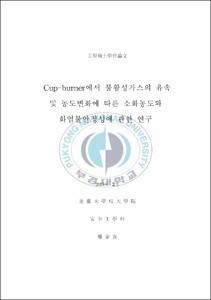Cup-burner에서 불활성가스의 유속 및 농도변화에 따른 소화농도와 화염불안정성에 관한 연구
- Abstract
- In this study, the effects of the coflow velocity and the concentration on the flame extinction and stability were investigated experimentally in the cup burner flames. Heptane used as fuel and four inert gases (N2, CO2, Ar, He) were added into the air in oxidizer stream, of which velocity was varied from 2 cm/s to 16 cm/s.
The concentrations of nitrogen, argon, and carbon dioxide at blow out are increased with increase of oxidizer velocity but that of helium is almost constant regardless of oxidizer velocity. This result might be attributed to the fact that the velocity effect is not noticeable relatively because of the higher thermal conductivity and diffusivity of helium. Also, the higher coflow velocity induces the lower burning rates of heptane. The flickering frequency decreases with increasing the coflow velocity. The higher oxidizer velocity induces the lower fuel velocity because aerodynamic effect results in the reduction of heat transfer near flame base. The frequency-buoyancy relation with non-dimensional variables coincides with that of buoyant flume and pool fires under ambient air when the characteristic velocity is defined to the difference between fuel and oxidizer velocities. This supports the fact that the origin of the gravitational instability is Kelvin-Helmholtz instability in shear layer.
Also, the flickering frequency has an irregular pattern as nitrogen is added on the oxidizer stream. The irregularity of the flickering according to the concentration of nitrogen might be due to change of flame structure, which is not only influenced on the buoyancy forces by the density field change based on the heat release rate but also coupled with a different stability mode such as radial directional instability. Under near extinction condition, two kinds of instability are observed at anchoring base of the flame as well as at downstream. The occurrence of flicking motion according to the velocity can be understood by introducing the Richardson number for buoyant force and Kelvin-Helmholtz instability in shear layer. The instability observed at flame base can be classified into four modes, i.e. cell, radial oscillation, swing and rotating. However, it is difficult to find a governing parameter.
- Issued Date
- 2013
- Awarded Date
- 2013. 2
- Type
- Dissertation
- Publisher
- 부경대학교
- Affiliation
- 부경대학고 대학원
- Department
- 대학원 안전공학과
- Advisor
- 이의주
- Table Of Contents
- 목 차
제 1 장 서 론 6
1.1 연구배경 6
1.2 기존연구 9
1.2.1 화염소화농도 9
1.2.1 화염불안정성 특성 11
1.3 연구목적 14
제 2 장 실험장치 및 방법 16
2.1 실험장치 16
2.1.1 Cup-burner 16
2.1.2 질량유량 제어기 17
2.2 실험방법 및 조건 18
제 3 장 불활성가스 첨가에 따른 소화농도 19
3.1 주위류 유속에 따른 화염소화농도 19
3.2 불활성 가스계 물리적 소화기구 24
제 4장 헵탄풀화재의 화염불안정성 29
4.1 화염불안정성에 대한 유속 및 농도 효과 29
4.2 소화근처에서의 화염불안정성 40
제 5 장 결론 52
참고문헌 55
- Degree
- Master
- Files in This Item:
-
-
Download
 Cup-burner에서 불활성가스의 유속 및 농도변화에 따른 소화농도와 화염불안정성에 관한 연구.pdf
기타 데이터 / 1.25 MB / Adobe PDF
Cup-burner에서 불활성가스의 유속 및 농도변화에 따른 소화농도와 화염불안정성에 관한 연구.pdf
기타 데이터 / 1.25 MB / Adobe PDF
-
Items in Repository are protected by copyright, with all rights reserved, unless otherwise indicated.